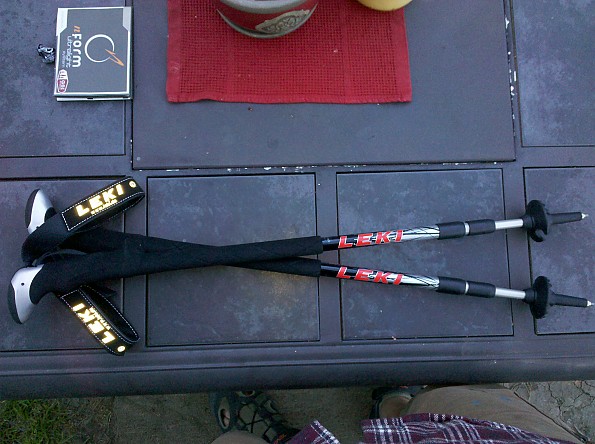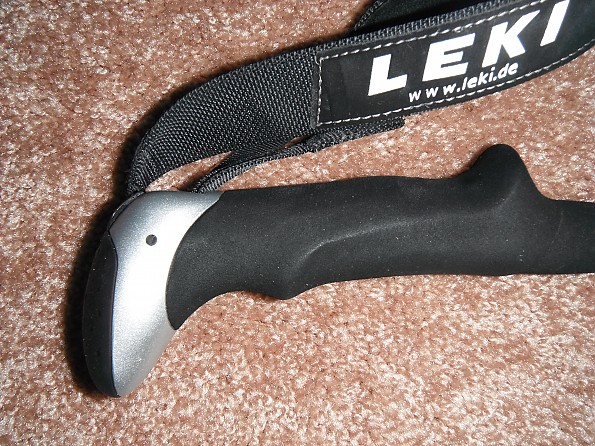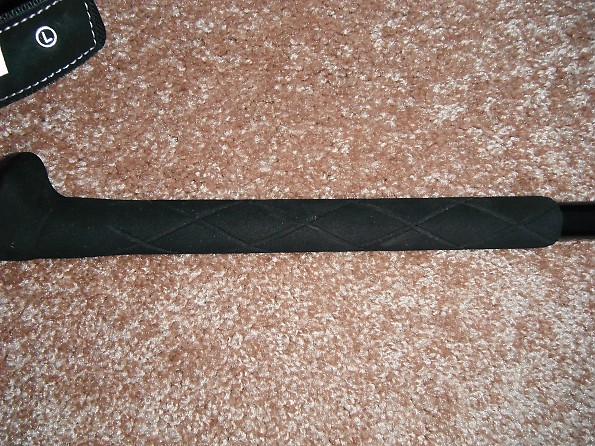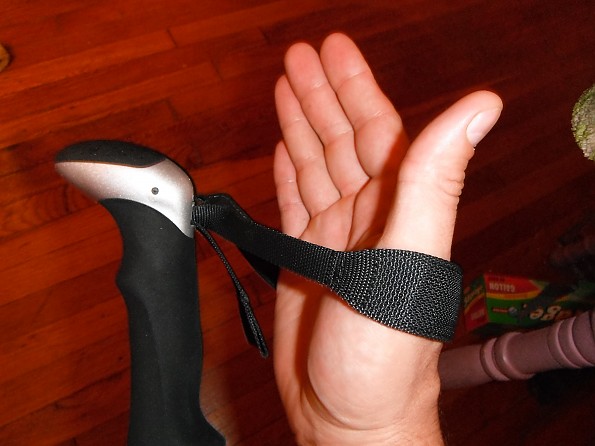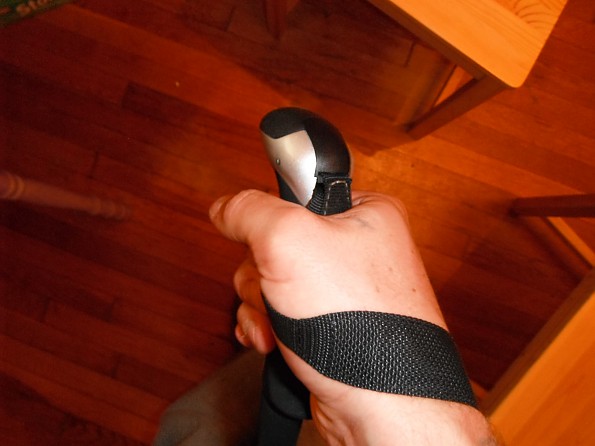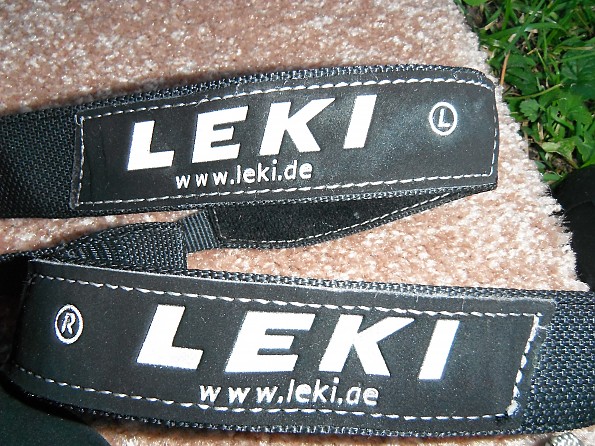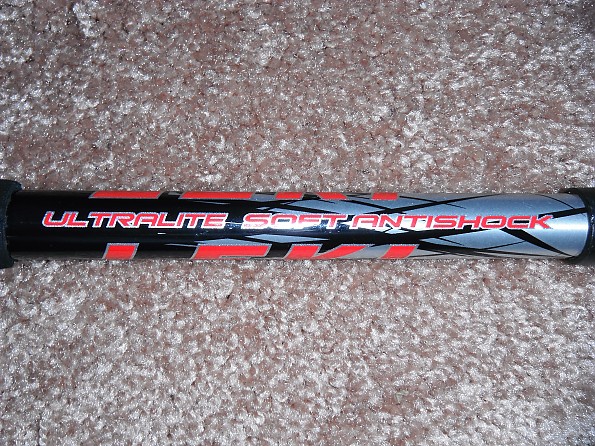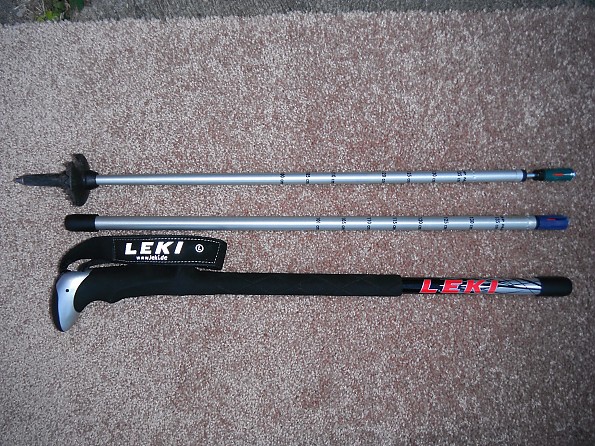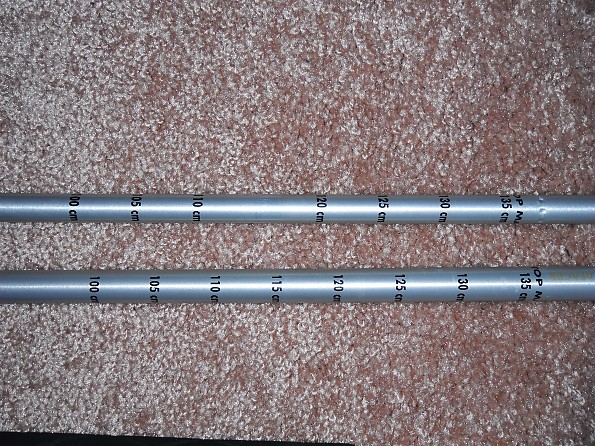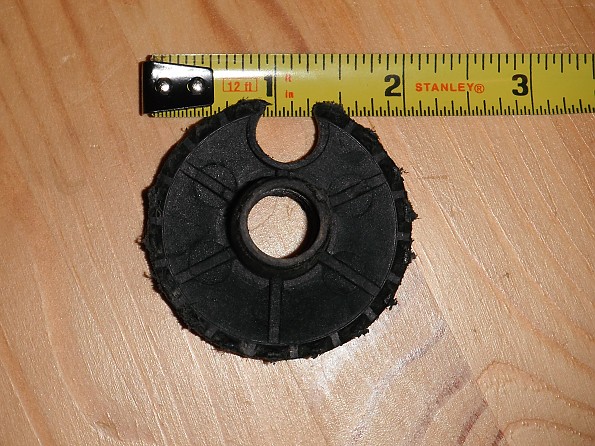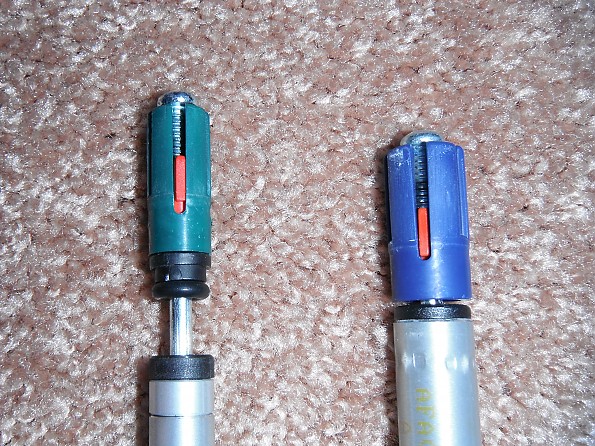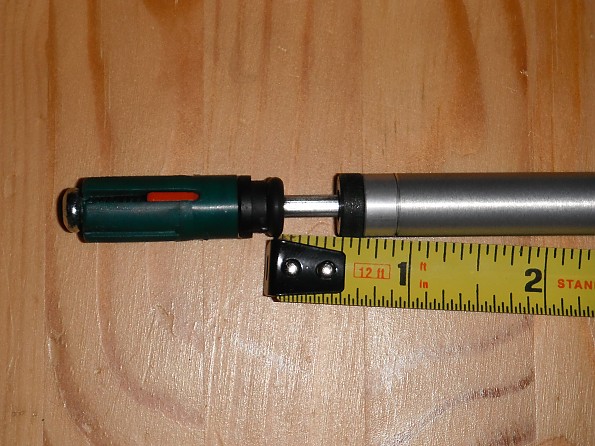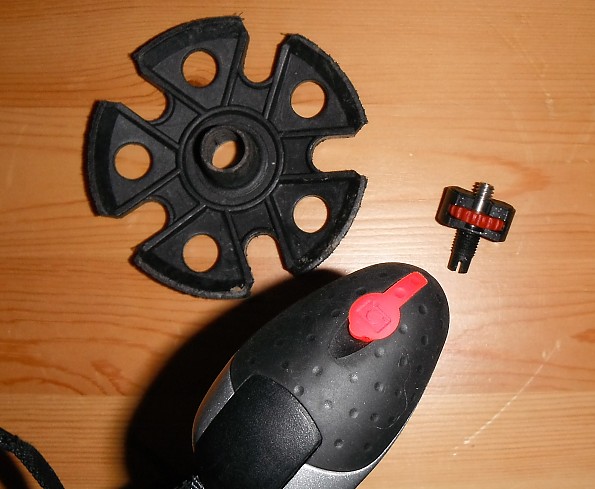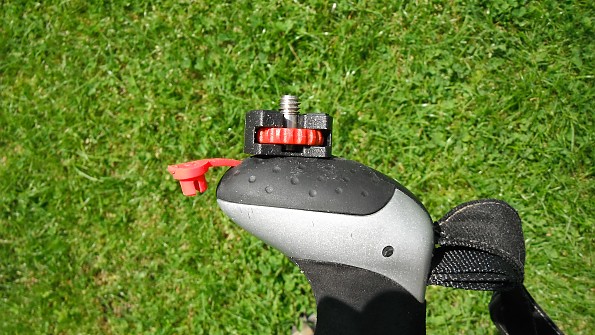Leki Thermolite Aergon XL Antishock

Pole model: Leki Thermolite Aergon XL Antishock
Pole type: Aluminum, collapsible, UL, antishock, trekking
Origin(manufactured): Europe
Trekking poles...
I have had many a conversation in regards to these "high-tech stability sticks" over time. Should I use them, why should I use them, what should I look for in a set of poles, should I spend a pile of money on a set or should I go to Wally-World and grab a set of cheap poles. It was enough to drive me mad... and it almost did....
Awhile back I decided to snag up a pair. I also decided to go with a reputable company as well. As I always say its the initial cost that is hard to swallow but if ya spend it now you will probably save money in the long run.
Here is what made this purchase such a fun and enjoyable(mind-numbing) situation.
It's all about choices...
Should I go all out for a set of carbon poles or would a lightweight aluminum set do the trick?
This is my personal take on the carbon vs aluminum subject.
Now while carbon provides a great strength to weight factor I find one major problem with them. If you get them caught up in rock and they snap you are stuck like chuck until you get off the trail and contact the manufacturer for a warranty claim.
This means you are carrying dead weight(granted it may not be a lot of weight) for the remainder of your trip if you are on the type of hike that has you miles away in the middle of "no man's land."
This may very well be another factor you may want to consider if you use your trekking poles to set-up your shelter (Nemo Meta, etc.)
Aluminum on the other hand will bend. Now if this happens you may very well be able to utilize the pole(depending on how severe the bend is) or bend it back and keep on trucking. This almost completely eliminates the dead weight issue I previously mentioned.
Now the next thing. Should I go with a standard set of poles or anti-shock models.
Uggghhhh. You can see where this can be a real hassle huh?
I have heard "with a standard trekking pole you can get serious vibrations depending on how rocky the terrain is."
Then there was the whole "if ya go with an anti-shock model they can bottom out hard and cause stability issues" theory.
I do a lot of inquiring and research when it comes to gear being I value my money and I want something for it. When it came to the stories about poles "the good, the bad, the ugly, I have probably heard 99.9% of them.
Then to make this whole purchase even more interesting there are choices when it comes to grip material(cork, foam, rubber.... wood maybe?)
Oh wait did I mention the different lock systems that are available?
Now after all of this I found myself considering 86ing the whole pole search, saving the cash, and scheduling an appointment with a therapist.
But.... my being stubborn as a mule would not let me succumb to the insanity I was experiencing and I pulled the trigger on a set of poles.
Enter Leki's Thermolite Aergon XL Antishock(try saying that 3 times fast. :)
Pros:
- Leki's warranty- lifetime
- Lightweight- 17oz/pr.
- AERGON Thermo XL Grip- very comfortable in the hand
- Soft Antishock System Lite- short travel shock absorption system
- Carbide Flextip(replaceable)- I have yet to find a surface in the backcountry that they will not grip solidly on
- Interchangeable Basket System- basically just unscrew them to swap them out for the snow baskets or replacements
- Super Lock System- I have yet to have the poles collapse on me or any other problems for that matter
- Highly adjustable- Length: 65-135 cm
- The adjustable wrist straps- Leki got this one right. Let's just say they are very comfortable
- Easily serviced by the owner
- User friendly
Cons:
- I honestly want to say the MSRP ($149) but... It is truly not hard to find these poles for around $110+. Just for the warranty alone this is a fair price when you consider the quality poles you are getting.
Meat and potatoes...
Exterior features/construction:
I am going to be up front and honest here. I really love these poles and I am extremely happy with my purchase. If you want to take the time to read further I will get into why I have such high regards for these poles.
Here is a rundown from top to bottom of the poles.
AERGON Thermo XL Grip:
The grips on these Leki poles are awesome. No matter what the weather conditions they remain comfortable. I have not experienced any chafing or blistering on the multiple 80 mile trips that I have used these poles on.
The grips consist of a material that Leki simply calls "thermo-foam."
I have used these poles in very hot temps (heat index over 100) as well as in downpours. These grips perform exceptionally well. Not only did my hand not get overly sweaty in the heat but when wet grip is not effected in the least.
As you can see in the above photo the top of the grip has a natural contour to it which gives one the ability to comfortably palm the pole if the situation arises where one needs to do so. This method would most typically be utilized when one is descending and the ground where one is planting their pole is at a lower elevation than the ground they are standing on.
Another nice feature of this design is that it is edgeless. Now some may very well over-look this when it comes to the grips but it is most certainly noticeable. If the grips were to have edges your hand may very well let you know how unhappy they are after hours of use on the trail(blisters, chafing.)
Another great feature of this grip design is that it incorporates a thermo-foam extension that extends 7.5" down below the actual grip(see below photo.)
This gives you the ability to adjust your grip on the pole without having to adjust the pole itself during ascents. Simply put, if you are ascending, the terrain ahead of you is going to be at a slightly higher altitude than the terrain you are standing on. If you lower your grip on the pole this will compensate for the difference in elevation.
Support Straps:
Leki really got this one right.
For one the straps are very comfortable(when used correctly.)
Now I am not saying people do not know how to utilize the straps on a set of poles but for those who do not I am going to provide a brief explanation on how to utilize them correctly. This can make a world of difference when it comes to the experience one has when using a set of poles.
First you place your hand up through the bottom of the strap as seen in the photo below.
Next take your hand and drop it straight down aligning the strap webbing in between your thumb and index finger as shown in the photo below.
Lastly, take your hand and drop it straight onto the grip as you see in the photo below.
Ok, now that we have that one cleared up Leki (imo) did a superb job on these straps for a few reasons.
- They are very comfortable. The interior of the strap that actually makes contact with your wrist is a very soft material. I have experienced no discomfort when utilizing these straps for prolonged periods on the trail.
- They are very easily adjusted. If you take a look at the photo below you will see the unlocked position on the left and the locked position on the right.
To adjust you simply pull up on the portion of strap that is closest to the top of the grip to unlock it, get the fit dialed in, and lock the cam by pressing down on the top of the cam with your thumb until it locks. Pretty simple huh?
Another nice feature of the straps is if you look at the photo below you will notice that not only are the Leki tags on the straps reflective but they are also marked R & L.
The purpose for this is the grips on the poles have different angles which are designed for maximum control and comfort for their designated hand. If you were to place the pole marked R in your left hand and the pole marked L in your right you will notice a substantial difference in feel and comfort. I did this just to see if there was a difference and it was quite odd feeling.
Shafts:
The shafts are a 3 piece collapsible design. They are made from high grade, heat tempered, aircraft aluminum.
The finishing process for the shafts consist of a 6 step process.
- You have your blank(aluminum)
- the process of chemical free grinding is incorporated
- a 2nd process of chemical free grinding is performed once again
- the shaft is then powder coated
- the designs(graphics) are applied
- and lastly is a Nanotec coating
The upper section of the shaft is where the grips, straps, and graphics are located. This is the thickest portion of tubing.
You have seen the grips and straps previously so here is a shot of the graphics.
The middle section of the shaft is a slight bit smaller and the lower portion is even smaller in diameter.
Both the middle and lower sections of the poles are marked 100cm to 135cm as seen in the above photo.
I actually took the liberty of doing a side by side measurement of the poles collapsed vs fully extended and came up with the following measurements in inches.
Collapsed: 26"
Fully extended: 54.5"
I have a photo of it but its pretty hard to see the tape so you are just going to have to trust me on that one. You do trust me don't you? :)
I would also like to point out that there is a marking on the lower 2 sections of poles that say "stop max" which you can see in the photo below(above 135.) This means that you basically do not want to extend the shafts any further or you will risk not only damage to your poles but also potential damage to yourself.
Baskets:

The baskets primary function is to keep the poles sinking into the mud to a minimum. I measured them in at 2" as you see in the photo below.
Also you will notice the cut-out in the basket. This is utilized to clip the poles together when not in use for transportation purposes.
The baskets are easily removed with the "righty-tighty, lefty-loosey" method (tip up.) This is for either the replacement of the stock baskets or to swap the smaller baskets out for snowflake baskets that are available through retailers.
Tips:
The tips on the poles are what Leki refers too as their Carbide Flextip. I have to say I am quite impressed with these tips. Whether its slick-rock, ice, or anything else that I have planted them on while on the trail they have stayed put. I have the utmost faith in them.
Another nice feature about this tip is that it can bend up to 30° without damaging the pole shafts. They are also replaceable.
Here is a photo of the Flextip without the basket.
Techy stuff on the inside...
Super Lock System (SLS):
I trust these poles with my life and I have on more than one occasion done exactly that. I have no doubt in the capabilities of the lock system. I have used them in various conditions over many miles and I have not ever had any type of occurrence in regards to the poles slipping out of adjustment or collapsing. They are very stable and that is putting it very mildly.
These poles utilize Leki's Super Lock System. I have heard the whole Flick Lock/Super Lock debate many times and I have also heard of some of the problems that people have with the Super Lock System.
The biggest problem I have heard is that people twist the poles to no end and they don't lock. This is actually caused by user error. This happens when one overly turns the shafts too many times counter clock wise(tip up) too loosen them for the purpose of collapsing or extending and the red expander in the lock system runs off the threaded bolt it travels on.
This is easily remedied by taking the poles apart and re-threading the expander.
You do not have to turn the shafts many times to get them to lock or to loosen them for adjustment.
Tightening- with the tip up turn the shafts clockwise until you feel them tighten. You do not have to wrench on them to get the locks to engage.
Loosening- with the tip up turn the shafts counter clockwise until you feel them loosen. Once again you do not have to max them out. If you stick with this method you will experience no problems with this system. I haven't.
All of the components to this lock system are replaceable through Leki.
See pic below for clarification.
In the above photo the blue (16mm) lock set-up on the right is the middle section and the green (14mm) one on the left is the lower section. Notice on the lower section in between the green lock and the shaft itself there is an exposed thin metal rod? This is the Soft Antishock System Lite that is incorporated into the pole.
There is approximately .5" of travel with this system as seen in the above photo. It works very well. I have not experienced any harsh bottoming out or rebound issues with this system. Its just enough. Not too little, not too much. Its just plain and simply put... Perfect as it is.
Accessories:
Leki has a few optional accessories for these poles. The number 1 item on my list is the Aergon Photo Adapter. Think mono-pod. Hey I like pictures (isn't it obvious?)
Here is a link for a list of the accessories offered by Leki for their lines of trekking poles.
http://www.leki.com/trekking/accessories.php
Areas and Conditions of use:
I have used these poles on quite a few weekend journeys on the Laurel Ridge here in Sw Pa. as well as a few 80 mile trips on the LHHT in various weather situations. Cold with snow, hot & humid weather, rain, rain, and more rain...
I have to say through all of these different temperature ranges and conditions not once did I lose faith in the capabilities of these poles.
Summary:
The Leki Thermolite Aergon XL Antishock is an awesome set of poles with a rather long name.
I have put many, many miles on these poles and I have to honestly say that there is absolutely not one thing that I dislike about them.
They have saved my tail quite a few times when my footing wasn't as solid as I anticipated. Like I said previously I trust them with my life.
When using poles in general I have noticed that I develop a rhythm. They have increased my speed on trail, saved my tail from quite a few ER trips(maybe worse,) saved my knees, and they have kept me moving on long mileage days(30+) when my legs wanted to call it quits.
I can honestly say that I will not hit the trail without my trekking poles due to the significant benefits that I have experienced from using them.
They have definitely made their place in my collection of gear and I cannot recommend them enough.
Let's face it. Yes they are expensive...
Then again how expensive are they when compared to a trip to the ER and the days off work from an injury on the trail that may have very well been prevented by using a pair of trekking poles? Not very expensive at all as far as I am concerned.
On trail(LHHT):
In closing:
I hope if nothing else you have gained a little knowledge in general in regards to the mechanical aspects, technology implemented, and just the over-all benefit of using a set of trekking poles on your travels.
Thanks for taking the time to read this review. I hope you enjoyed reading it as much as I enjoyed sharing my experiences with you.
Happy hiking — Rick
Update: February 2, 2012
I have since added the Leki Aergon Photo Adapter to my poles. For anyone out there who owns a set of Lekis with the Aergon grips and loves to take photos I highly recommend this conversion.
I also added snowbaskets for winter use.
I have hammered on these poles through four seasons and I have to say I am very happy with them.
They still look new... well the tips and baskets show wear which is to be expected (both of which are easily replaced for around $20 USD combined).
With the addition of the Photo Adapter I have to say I am really happy. The Photo Adapter makes life a lot easier for me compared to the past where I was taking self portraits with the cam in one hand while trying to maintain balance and making sure I made it in the pic as originally intended.
See pics below:

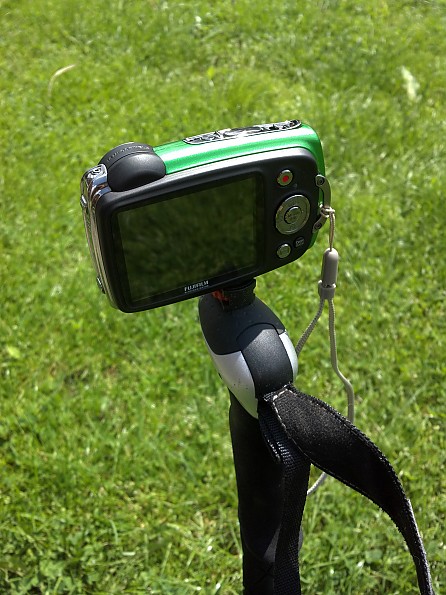
What an awesome product Leki has here, and now an awesome set of poles with mono-pod capabilities.
I couldn't be happier with my purchase and would purchase this set-up again in a heartbeat.
I will be firing out a review on the Photo Adapter in the not so distant future.
Update From July 2012 trip:
During my last trip week long solo trip on the LHHT I encountered an odd problem with these poles. I extended them as they normally would but they would not unlock so I could collapse them. This happened with both poles.
I could turn the shafts but they would not unlock regardless of how hard I tried.
I contacted Leki and they sent me out brand new middle & bottom sections for both poles as replacements as well as new tips.
When I contacted Leki they told me that this was an issue that they were not familiar with but nevertheless replacement shafts were already on their way from the warehouse.
Kudos to Leki for taking care of my issue.
Regardless it was still a problem that effected the performance of the product so I am deducting 1 star from the rating.
If I wanted poles that didn't collapse I would be carrying ski poles on trail...
Source: bought it new
Price Paid: $120 (MSRP $149)
Trekking poles are a great addition to your hiking gear. Leki Thermolite Aergon Antishock poles strike the balance between reasonable price and high quality.
Pros
- Quality construction
- Light weight
- Can be adjusted on the fly
- Replaceable tips for different terrains
- Sturdily constructed cork handles
- Reasonable price
Cons
- None
Until a few years ago, I thought trekking poles were a fad that would soon pass. That was before I bought a pair. Now, I would never backpack with them.
One of my first tasks on a multiday hike used to be to find a nice walking stick among the branches that had fallen beside the trail. Sometimes I found a keeper, though not always. Even when I was younger, I liked to have a walking stick to ease the burden a bit on a steep uphill hike or to slow myself down on a perilous downhill trail.
After seeing them on a trip to Switzerland, my wife started using "Nordic walking poles" to do day hikes and even on brisk walks through our neighborhood. She raved about how the poles took the strain off her knees and also helped her maintain a faster pace. She wanted me to try them, but I thought they looked pretty dorky, especially in the suburbs. After a strenuous hike in the N.C. mountains a few months later, though, I decided I should see if trekking poles would make a difference.
Like most people, I spent a few weeks doing Internet research. I decided the rapid-lock/unlock feature was important, as well as light weight and sturdy construction. Some people prefer poles that are a set length. In my case, I figured I would want to adjust the pole length depending on the degree of incline. The catch, though, was to find adjustable poles that wouldn't slip. The Leki line of trekking poles got good reviews. I decided on the Aergon XL antishock poles after finding them on sale at Sierra Trading Post.
Now that I've used the poles for a couple of years, I can't imagine hiking without them. They certainly take away much of the strain on my knees, during descent as well as ascent. I used to have knee pain after long downhill hikes, even when I was careful not to let all my weight come down too forcefully. With these trekking poles, I'm able to transfer a lot of the weight off of my knees, and I seldom experience knee pain even though I'm not so young any more.
The Lekis have performed well, permitting me to rapidly change pole length and never slipping. They are just the right weight, too.
The handles are cork, which I thought might disintegrate over time, but that hasn't been the case. They seem to absorb sweat without decomposing. Maybe that's an intrinsic quality of good cork. The straps are a very important part of the pole, as they keep the pole secure in your grip. The Lekis' straps are so comfortable on my hands that I hardly know they're there.
The pole tips are a durable carbide which works well for most trails. You can add a rubber boot tip if you want to use your poles on asphalt, rock, or other hard surfaces.
Source: bought it new
Price Paid: $80
First I would like to say that I used to be opposed to trekking poles. To me they seemed like a waste of time, weight, and money. I wouldn't even consider buying a cheapo $20 pair from Wal-Mart let alone blow $150 on some supposedly lightweight, aircraft grade carbon shafted, anti-shock poles or whatever they say to sell poles these days.
Whatever the reason, one day I saw the Thermolite Aergon XL Antishocks in my local outdoor gear shop and I was drawn to them. I don't know why. They had one on display and I grabbed it. It fit my hand like a glove. It was perfect. I walked to the counter, dished out 150 smackers, and left the store in a daze.
I got outside and realized, "I hate trekking poles. Why did I just drop $150 dollars on a pair?" Well, I can tell you that these poles are worth every stinking penny.
I recently took these poles with me on a trip in the Sangre de Cristo Mountains in Colorado and they made the hike up the mountain seem like a breeze. I only used one and my girlfriend used the other. The carbide tips grabbed rocks like glue and never slid, even in the continued downpour. Once we got to our destination they made setting up my MSR E-Wing shelter so much easier.
On the way down I used both poles as my girlfriend didn't want to use one. They made the trip down so much easier on the body. My balance was greater and I felt like a mountain goat hopping down the rocky trail. The grips offer plenty of airflow and I didn't get sweaty palms the entire trip.
The antishock is a great feature that helps when you're constantly slamming poles into the ground up and down mountains. Leki knows what they are doing. These are great poles and I would definitely buy these poles again. Not a doubt in my mind.
Price Paid: $150
Excellent design, feel, and price! I love the antishock feature and really like the aergon grips. I was thinking about the cork grips, but to be honest they were not nearly as comfortable. Locking system is solid and will not budge when set. Awesome brand and fantastic product
Pros
- Strong
- Lightweight
- High quality
Cons
- Speed lock system is more convinient when adjusting
Fantastic poles for backpacking. Loved the quality and features. Will use these for years to come. Fit was great, locking was solid, antishock feature is a big plus, and traction is superb.
Your Review
Where to Buy
You May Like
Specs
| Price |
MSRP: $179.95 Historic Range: $79.98-$179.95 Reviewers Paid: $80.00-$150.00 |
| Weight |
16.4 oz |
| Length |
66 - 135 cm |


